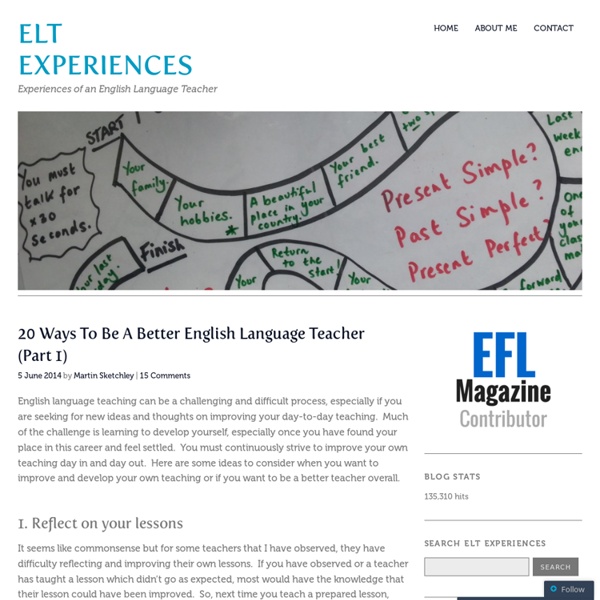Lizzie Pinard - Course books in the language classroom: friend or foe?
This is not the first time I’ve discussed or reflected on the use of course books in the classroom, neither, I’m sure, will it be the last. While in my first post-CELTA job, I initiated an #ELTchat discussion entitled “How to avoid death by course book?” – the summary of which can be found here – which hints at my feelings towards course books at that time! Since then, and via a lot of teaching, learning (both on the job and during my Delta/M.A.ELT year at Leeds Metropolitan) and reflection, my relationship with course books has evolved… How do I feel about using a course book? I think it doesn’t have to be as bad as might sometimes be assumed. For me, the course book is a cookery book. Instead of dismissing your course book out of hand and assuming that you know better (hey, you might – but not necessarily!) Ask yourself these questions: What is the purpose of this sequence? (You could look in the Teachers Resource Book, if you have access to it, to explore this further. McDonaugh, J.
Flashcards in the Classroom: Ten Lesson Ideas | ELT Experiences
The other day, I was preparing a lesson with an intermediate group of young learners and getting my flashcards printed and laminated. However, when chatting to some other teachers in the staffroom, with myself behind the laminating machine, there was a brief comment that flashcards are more suited for beginner or elementary learners and more appropriate for young learners. Flashcards are really good but more suited for young learners or really low levels of students. Unfortunately, I really have to disagree with this sentiment as I have used flashcards with many different levels as well as ages of learners. With this post, I really would like to push the boundaries of what is considered suitable for learners and offer teachers practical ideas on how they are able to incorporate flashcards into lessons with more than just young learners or beginner/elementary classes. 1. The most common use of flashcards in the classroom is for drilling and checking pronunciation with the class. 2. 3. 4.
Europeisk språkportfolio - pedagogisk verktyg för lärare
Språkportfolion hjälper eleven att bli mer medveten om sitt eget lärande. Både eleven och läraren får syn på vilka kunskaper eleven har och vad han eller hon behöver lära sig mer om. Äldre elever kan använda dokumentationen inför studier utomlands eller för att söka ett arbete. Språkportfolion ersätter inte betyg, certifikat eller diplom utan är ett komplement till formella examina. I språkpasset dokumenterar eleven vilka språk hon eller han kan, hur väl hon/han behärskar dessa och var hon/han har lärt sig dem. Eleven skriver också en översikt av sina examina i språk och språkpraktik. I språkbiografin planerar, bedömer och reflekterar eleven kring sin inlärning av olika språk och sina kulturella erfarenheter. I dossiern samlar eleven ett urval av sina arbeten. Handledning - ESP 6-16 år (3,5 MB) Handledningen innehåller förslag och instruktioner hur du och dina elever kan planera och arbeta med språkportfolion. ESP 6-11 år, interaktiv pdf (1,0 MB) Mitt språkpass 6-11 år (1,8 MB)
Roar – Katy Perry – ESL lesson plan | Anna Edu
The song “Roar” perfectly fits the topic of gender roles/stereotypes, feminism. Besides, it’s a great source of idioms, set expressions and phrasal verbs. That’s how I would use it in class. 1. 1. 2. 3. 4. 5. in ESL lesson plans by Anna
Simulations Can Change the Course of History . . . Classes
I went to a Professional Development workshop several years ago with a master history teacher, Eric Rothschild, who spent his career teaching at Scarsdale High School. He was a brilliant workshop facilitator, and I learned more about teaching history in that workshop than in any other professional development experience I'd had up to that point in my career. He ran a workshop on teaching AP U.S. History, and it was unlike anything I had seen before. He introduced me to the idea of using simulations to teach the AP course, and also to the principle of fostering student ownership, with a strong foundation in historical research. After taking his workshop, I began to apply his approach to teaching AP European History and found it to be liberating and transformational as a teacher. With each unit of study, I made sure to incorporate an active simulation, ranging from mock press conferences and trials to murder mysteries and dinner parties, from spy dilemmas to mock Survivor games. 1. 2. 3.
.facebook_-1027388451
4 ways to use YouTube in the language classroom
UPDATE: I’m delighted to say that this post has been nominated for the British Council’s TeachingEnglish blog award for innovative teaching ideas. I’m really delighted to have been included in this month’s nominations, so… make me a super happy boy by clicking here and voting for me! When it comes their language learning I can safely say that my teenage students always enjoy the multimedia experience.Rather than studying grammar and vocabulary through boring old course books, they find it more exciting to watch action unfold via moving images on their laptop, tablet or smart phone. I’m an avid user of short clips in my classrooms. 1. Don’t go into this without a specific purpose in mind. Suggested resource: Here’s how I use YouTube to teach and review conditionals 2. Short video clips are such a natural way of practicing listening and comprehension skills with your learners that they simply shouldn’t be overlooked. Suggested resource: Mr Bean’s official YouTube channel 3. 4.
Schoolshape | Learning Technology



